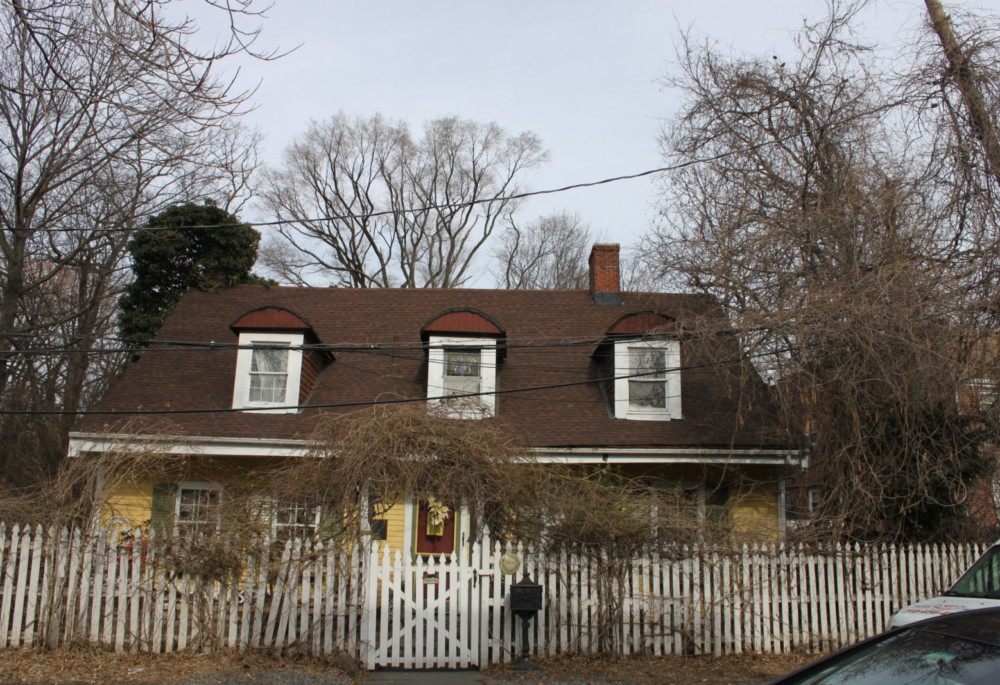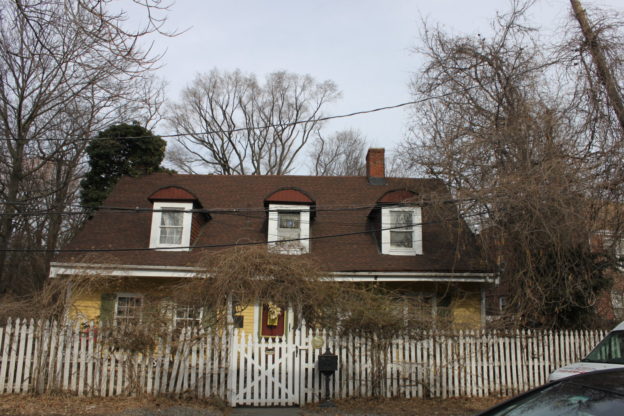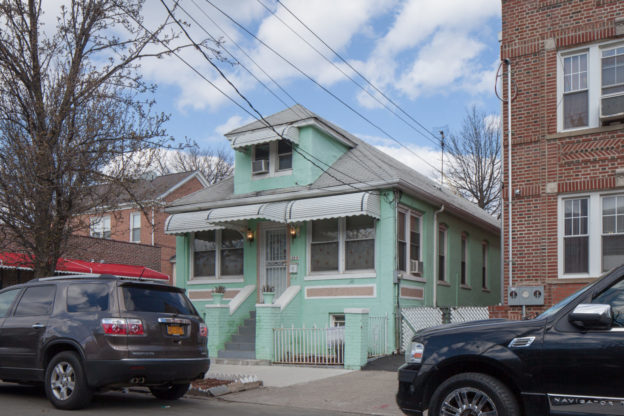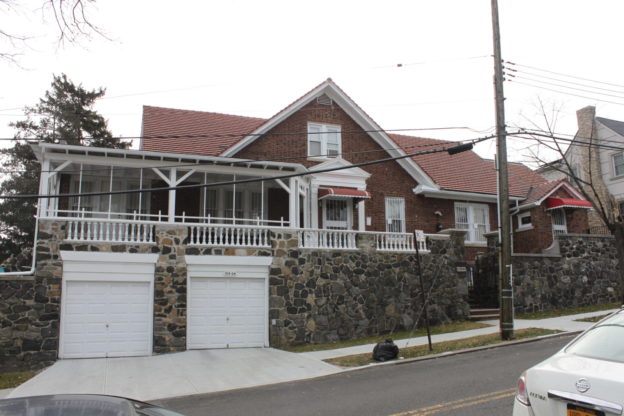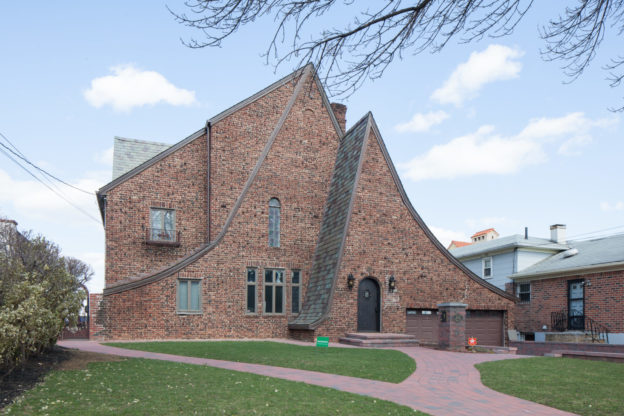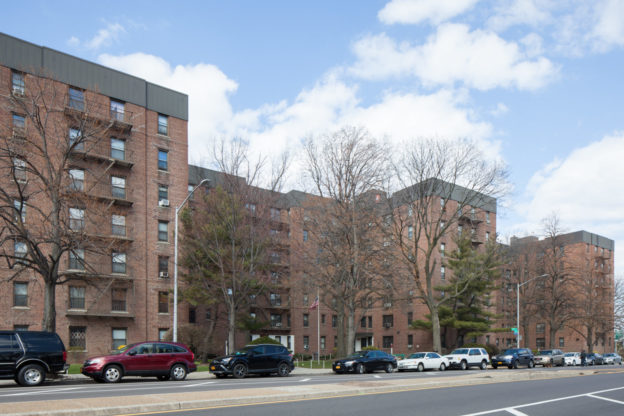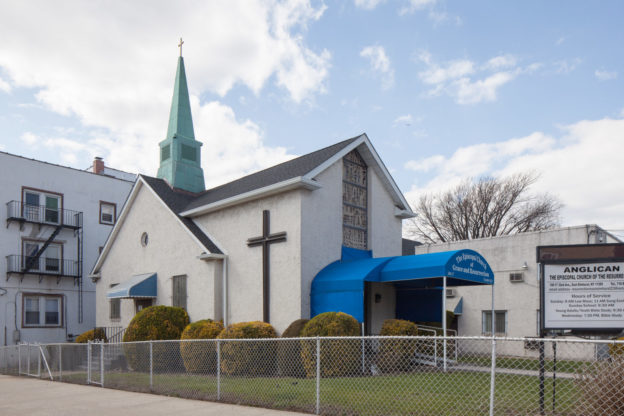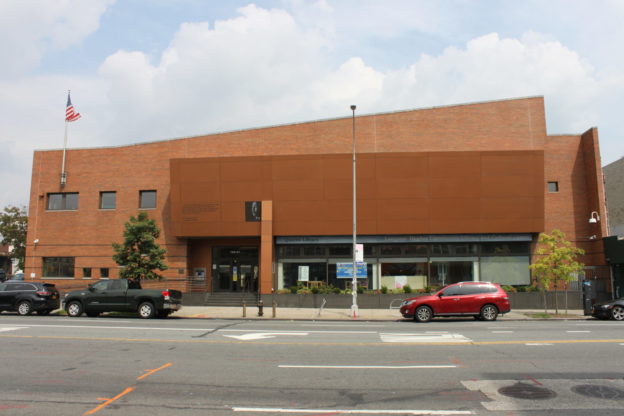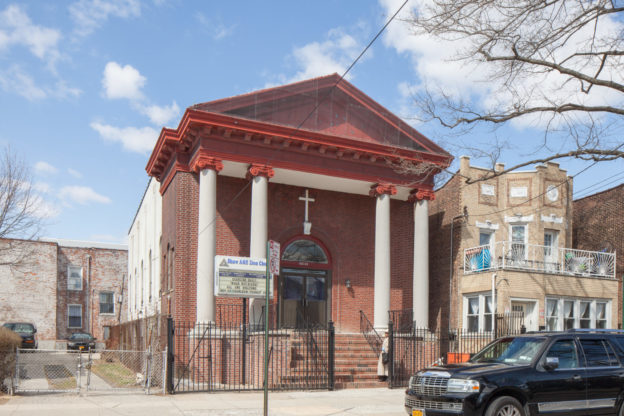78-03 19th Road
c. 1729
The oldest building in New York City still used as a private residence, this Dutch Colonial Farmhouse was built circa 1729 by Abraham Lent, grandson of Abraham Riker, using local stone and roughhewn timber. The locally prominent Riker family was the namesake of nearby Rikers Island. The property contains a small cemetery containing the graves of family members, as well as that of Williams James MacNeven, an Irish patriot and pioneering physician who had stayed with the Riker family before his death. Portions of the farmhouse were damaged by fire in 1955, but the property was fully restored by the current owner Marion Duckworth Smith and her late husband, Michael Smith.The Lent-Riker-Smith Homestead is an Individual Landmark and listed on the State and National Register of Historic Places.
104-04 Ditmars Boulevard
This approximately 1,000-ton boulder, a neighborhood icon, currently sits in the LaGuardia Plaza Hotel’s parking lot, but was once surrounded by empty land. It was a popular playing ground for children and inspired such affection that neighbors have rallied against its removal on multiple occasions. The Giant Rock was brought to its present location (probably from southern Westchester) by an ice sheet approximately 10,000 to 12,000 years ago.
75-20 Astoria Boulevard
Alexander D. Crossett & Associates, Aymar Embury II consulting architect
1953
This 400,000-square-foot complex was built to house offices, state-of-the-art laboratories (occupied by 140 research scientists), extensive manufacturing facilities (staffed by 2,000 workers), a 500-car parking garage and a public recreation field. Founded in 1875 as the J. Bulova Company, the firm achieved fame both for its innovative timepiece designs and marketing campaigns. In the 1920s it produced some of the earliest radio advertisements, and in 1941 aired what is considered the first television commercial. Bulova also affiliated itself with the burgeoning aerospace industry, offering Charles Lindbergh a prize for his pioneering trans-Atlantic flight and sending watches to the Moon with NASA astronauts. Inspired by the Federal Reserve Bank in Washington, DC, this limestone-clad building’s style is a bit old fashioned for its time of construction. Its Stripped Classical design more closely resembles buildings from the 1930s, such as the New York City Building from the 1939 World’s Fair, also designed by Embury. Nevertheless, it won the Queens Chamber of Commerce’s Outstanding Building Award in 1953.
23-11 97th Street, Malcolm X Place
1925
Malcolm X, civil rights leader and former figurehead of the Nation of Islam, lived in this bungalow with his family from 1959 to 1965. Born Malcolm Little in Omaha, Nebraska, in 1925, by the 1940s he was living in Boston, where he was arrested for robbery and sent to prison. During his incarceration, Little was introduced to the religious and political movement known as the Nation of Islam (NOI), and corresponded regularly with its leader Elijah Muhammad. Before his release in 1952, Malcolm joined the NOI and changed his name to “Malcolm X”. In 1960, Malcolm established Nation of Islam Temple 7B at 105-01 Northern Boulevard, just blocks from the original Langston Hughes Community Library and Cultural Center. It is now the Masjid Nuriddin & Clara Muhammad School. In March of 1964, Malcolm X publicly announced his break from the NOI, and in April, flew to Jeddah, Saudi Arabia, at the start of his Hajj (pilgrimage to Mecca). He thereafter became known as el-Hajj Malik el-Shabazz. Upon his return he expressed that seeing Muslims of all races and backgrounds interacting as equals led him to see Islam as a means by which racial problems could be overcome. After his break with the organization, the NOI began eviction proceedings to remove Malcolm X and his family from the house on 97th Street, although Malcolm Little was the signature on the deed. On February 14, 1965, the home was set ablaze by Molotov cocktails. The family escaped the fire and was given refuge by neighborhood residents. One week later, on February 21, 1965, Malcolm was assassinated while making a speech at the Audubon Ballroom in Harlem. Malcolm X’s presence is still felt in the community and he is a revered local figure. In 2005, the street in front of the house was renamed Malcolm X Place.
109-04 31st Avenue
c. 1925
This American Craftsman style residence was home to William Francis Kenny, Jr., known professionally as Bill Kenny, a pioneering tenor vocalist with the Ink Spots, a popular vocal group that prefigured doo-wop and rock and roll. Kenny, whose vocal range spanned four octaves, joined the Ink Spots in 1939 at the age of 17, and sang on the group’s first hit, “If I Didn’t Care,” with fellow East Elmhurst resident Orville “Hoppy” Jones. Kenny shared the home with his wife, Audrey, and their daughter. Kenny, as one of the Ink Spots, was inducted into the Rock and Roll Hall of Fame in 1989.
105-19 Ditmars Boulevard
c. 1922
Ella Fitzgerald, America’s “First Lady of Song” (born in 1917 in Newport News, Virginia), got her start as a teenager by winning an amateur singing contest at the Apollo Theater in Harlem. She made her first recording in 1936, and in 1938 found fame with a hit rendition of “A-Tisket, A-Tasket,” recorded with the Chick Webb Orchestra. Fitzgerald was a tireless performer, beloved and admired by audiences for her remarkable vocal range and indelible personal style. Nevertheless, she kept her personal life quite private. After a brief first marriage that ended in annulment, Fitzgerald married renowned jazz double bassist Ray Brown in 1948. Their marriage lasted only four years, during which time they lived in this impressive Tudor Revival style house. Fitzgerald later resided in a home in the Addisleigh Park Historic District in eastern Queens until 1967, and died at her Beverly Hills home in 1996.
112-24 Northern Boulevard
1950-53
Built at a time when segregation was widely enforced, the Dorie Miller Co-op was a rare integrated housing development. Originally conceived exclusively for African-American residents, it became “open occupancy” in large part at the urging of Congressman and pastor Adam Clayton Powell, Jr. (who presided over the opening ceremonies in 1953). The co-op’s early residents were a mix of African- American, Jewish, Caucasian and interracial families—many coming from Powell’s home neighborhood of Harlem. The complex was named for Doris “Dorie” Miller, a World War II hero and the first African-American to receive the Navy Cross, for his actions at Pearl Harbor (Miller died in action in 1943). Comprising six towers, the development originally housed 301 families. Like the greater Corona-East Elmhurst neighborhood, the co-op attracted a number of famous jazz musicians including saxophonists Julian “Cannonball” Adderley and Jimmy Heath, trumpeters Nat Adderley and Clark Terry, and singers Olga James and Nancy Wilson.
34-34 98th Street, 1925
100-17 32nd Avenue, 1951-53
These sister congregations merged in 2016 to become the Episcopal Church of Grace and Resurrection, occupying the latter’s building on 32nd Avenue. Grace Episcopal Church was the slightly older congregation, founded in 1906 and organized in 1907 in a small chapel that later became its parish hall, located at 34-22 98th Street, “an attractive one story frame building, somewhat in the bungalow” style, according to the local press. Construction of a proper church was long planned but took a number of years to realize. The nearby Church of the Resurrection held its first service on Easter Sunday, 1923. Its congregation is comprised primarily of Afro- Caribbean and African-American families.
100-01 Northern Boulevard
Davis Brody Bond
1999
Now part of Queens Library, the Langston Hughes Community Library and Cultural Center was established in 1969 in response to local efforts to create a library and community center focused on the history and needs of the area’s African-American community. Local residents, including former Queens Borough President Helen M. Marshall, who served as the library’s first executive director before entering the political sphere, formed the Library Action Committee of Corona- East Elmhurst, Inc., which staffed the library from its opening until 1987 and is still responsible for operating the library’s Homework Assistance and Cultural Arts Programs. This purpose-built structure is the institution’s second home; its first was located in a former Woolworth’s department store on Northern Boulevard—the site of a civil rights struggle to break the color barrier for hiring in Queens. The library opened two years after Hughes’ death and includes a large collection of materials by and about the poet. The new building includes gallery, auditorium, research, archival and children’s spaces to hold its many performances, lectures and events celebrating black history and culture. The library is home to the Black Heritage Reference Center of Queens County, housing New York State’s largest public circulating collection of materials on the black experience, estimated at roughly 45,000 titles and including approximately 1,000 theses and dissertations on black literature. The institution is a touchstone in the community and an important reminder of the importance of advocacy and activism.
100-05 34th Avenue
Paul Roth
1923-24
Like Congregation Tifereth Israel, this synagogue’s architectural form is more reminiscent of the Lower East Side than suburban Queens. It occupies nearly the entirety of its long, narrow lot—almost as if anticipating tenements to be built on either side. The Northside Hebrew Congregation was organized in the early 20th century, by some accounts c. 1900 and by others c. 1913, but the present building was dedicated in 1924. At the opening ceremony a golden key was given to the architect by the congregation, which noted, “Roth, who is vice-president of the congregation, and his son, Harold Roth, donated their services in the planning and erection of the temple.” Its most prominent architectural feature is a Classical portico featuring four Ionic columns, triangular pediment and modillion cornice. Since 1957, the building has been home to the Shaw A.M.E. Zion Church.
